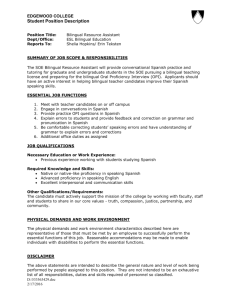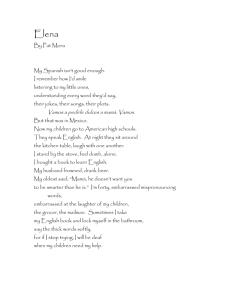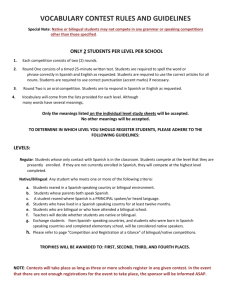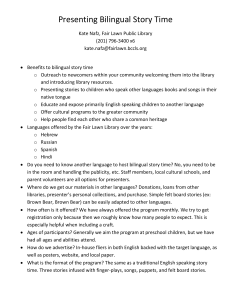File - Paola Treviño'sMaster's Porfolio
advertisement
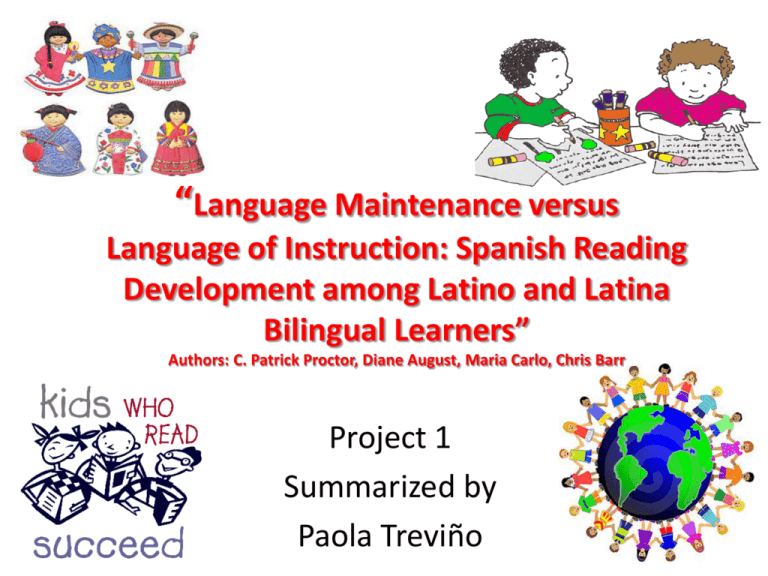
“Language Maintenance versus Language of Instruction: Spanish Reading Development among Latino and Latina Bilingual Learners” Authors: C. Patrick Proctor, Diane August, Maria Carlo, Chris Barr Project 1 Summarized by Paola Treviño Introduction Proctor, August, Carlo and Barr conduct a study of “101 Spanish-English bilingual Latino/a children in second through fifth grade in three urban U.S. districts.” According to the researchers “bilingualism is associated with achievement in both cognition and generally literacy, which are core components of academic development.” European Immigration Early waves of European Immigration have proven that heritage language loss occurs through generations. Newly arrived immigrants maintain their native language while learning some English. The first-generation children then take up the English becoming the dominate language. While the heritage language takes a backseat. Second generation children, lose most of the heritage language and only have the last remnants of the language through their grandparents. The third generation children have not almost completely lost the heritage language becoming monolingual speaking English. The generational language shift occurs in most new immigrant groups who migrate to the U.S. With the many changes in our world technology and globalization have impacted the way immigrants communicate between countries. Heritage language loss is present to this day with younger immigrants quickly learning English. A study conducted by Alba et al. showed the use of English in the homes of Chinese, Cuban and Mexican immigrant children significantly increased from first generation through third generation. Benefits of Bilingualism Effects on literacy, language and cognition and socioeconomic status Literacy: Native language literacy development does facilitate English literacy development. If the child is strong in their heritage language they will develop strong skills in the English language. Language and Cognition: Bilingual children have proven to make metalinguistic insights sooner and with greater depth than their monolingual peers. This means the learner’s insight into the nature of the language allows the transfer of linguistic knowledge across languages. Socioeconomic status: Children of low socioeconomic status have been associated with lower levels of school achievement. The children of this low socioeconomic status are also linked to limited access to resources such as printed materials. Unfortunately, low socioeconomic status is linked to family income and inability to obtain needed resources. The Study The researchers conducted a four year long longitudinal study of 101 students from El Paso, Texas, Chicago, Illinois and Boston, Massachusetts. Three types of instructional programs were used: English only, Spanish only and bilingual. Three main research questions were explored: 1. 2. 3. Does language of instruction promote or hinder English or Spanish reading comprehension among bilingual students? Are Spanish and English reading skills related to one another? If so, how? Do these relationships vary as a function of language of instruction? Do socioeconomic characteristics of the home lives of the children affect the Spanish reading achievement of the students? Data was collected five times during the study. The children were measured on English and Spanish reading comprehension and Spanish oral vocabulary. Results Spanish Reading Growth: • Students in the Spanish and bilingual groups outperformed their English instructed counterparts in Spanish reading. Spanish instructed students outperformed bilingual students. Overall the Spanish instructed students outperformed the English-instructed students. • English and bilingual instructed students were stronger English readers than their Spanish-instructed counterparts. However, neither group differed significantly from one another. • Decreases in test scores did show decreases in Spanish reading over time for the bilingual and Spanish-instructed students. This indicates that over time the students in these groups were losing ground in the Spanish language. • The English instructed group was significantly outperformed by both the Spanish and bilingual instructed groups in Spanish reading gains. This also results in the Spanish-instructed group to outperform their bilingual counterparts. Results Spanish Reading Comprehension: Spanish-instructed students outperformed both bilingual and English-instructed groups when using English reading and Spanish oral vocabulary to predict Spanish reading comprehension. Socioeconomic Variables: Variables of mother, father and household income showed minimal, indeed negative, yet nonsignificant, effects of SES on Spanish reading comprehension. Overall As we’ve learned in class it is important for a student to be strong in their native language and proficiently learn their second language. We read in the article “The Astounding Effectiveness of Dual Language Education for All” instruction given to the student is very important. Bilingualism is associated with the achievement of literacy of the student. In week two instructional approaches, transfer across language had mixed feelings and reviews from the researchers of “Teaching Struggling Readers Who Are Native Spanish Speakers: What do we Know?” This article resulted in the conclusion that learning in one language may not be transferred to another language. The bilingual instructed students in the article summarized were in fact losing their Spanish heritage language although being taught both English and Spanish. The students need to be literate in their native language to have positive outcomes when learning their second language. Reference Proctor, C. (2010). Language Maintenance versus Language of Instruction: Spanish Reading Development among Latino and Latina Bilingual Learners. Journal Of Social Issues, 66(1), 79-94



